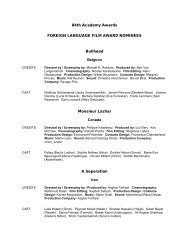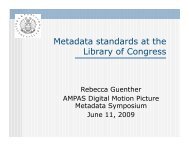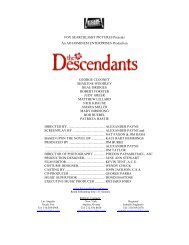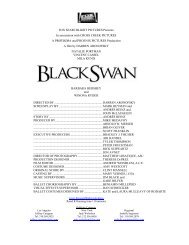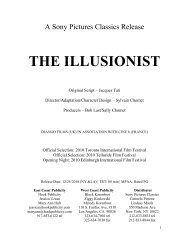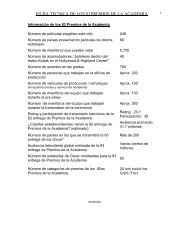Download Report - Academy of Motion Picture Arts and Sciences
Download Report - Academy of Motion Picture Arts and Sciences
Download Report - Academy of Motion Picture Arts and Sciences
Create successful ePaper yourself
Turn your PDF publications into a flip-book with our unique Google optimized e-Paper software.
to refer to a test which was recently made to determine<br />
this point, <strong>and</strong> which apparently demonstrated<br />
that the light from Inc<strong>and</strong>escent sources falls <strong>of</strong>f<br />
more rapidly than that from the Arc. The results<br />
<strong>of</strong> this test have been given considerable circulation<br />
<strong>and</strong> might serve to strengthen the belief <strong>of</strong> those<br />
who feel that there is a difierence in the rate <strong>of</strong><br />
light attenuation from Arc <strong>and</strong> Inc<strong>and</strong>escent sources'<br />
In the test re{erred to a man's face was illuminated<br />
by a 35-ampere, twin broadside Arc placed 2,<br />
4, 6, 8, 10, 12, 14 <strong>and</strong> 16 feet distances from the<br />
subject <strong>and</strong> a number <strong>of</strong> frames <strong>of</strong> film exposed at<br />
each lamp position, one-half <strong>of</strong> the film being masked<br />
<strong>of</strong>i. The film was then brought back to the starting<br />
point, <strong>and</strong> an Inc<strong>and</strong>escent source substituted for<br />
the Arc, <strong>and</strong> the exposures repeated so that the exposure<br />
for the Inc<strong>and</strong>escent lamp at, for example, 6<br />
feet, occupied the other half <strong>of</strong> the frames that the<br />
Arc lamp at 6 feet occupied. Thus an opportunity<br />
was given <strong>of</strong> comparing the illumination received<br />
from Arc <strong>and</strong> Inc<strong>and</strong>escent lamps at each distance.<br />
At the 2 <strong>and</strong> 4 feet distances both halves <strong>of</strong> the negative<br />
appeared equally exposed, but as the distances<br />
increased, the part <strong>of</strong> the negative illuminated by<br />
the Inc<strong>and</strong>escent light appeared less exposed, giving<br />
rise to the conclusion that the Inc<strong>and</strong>escent light<br />
fefi <strong>of</strong>f more rapidly. This test is misleading for<br />
two reasons: First, equal wattages or equal photographic<br />
illumination intensities at the start were<br />
iot employed. In the second place, the illumination<br />
received when the two sources were within 2<br />
to 4 feet <strong>of</strong> the subject, was so high that the photographic<br />
emulsion was undoubtedly operating beyond<br />
the straight line portion <strong>of</strong> its characteristic curve,<br />
so that the nearly equal densities obtained would<br />
not signify that there were anywhere near equal intensitiis<br />
<strong>of</strong> light from the two sources- As the distance<br />
between the sources <strong>and</strong> the subject were increased,<br />
the exposure obtained from the Inc<strong>and</strong>escent<br />
lamps dropped down on to the straight line<br />
portion o{ the characteristic curve before that from<br />
the Arc lamp, showing the effect <strong>of</strong> decreased illumination<br />
sooner than was obtained with the Arc lamp.<br />
Mn. Por.rnn: I think your explanation is exactly<br />
correct, <strong>and</strong> if you start with equal illumination<br />
there is equal carrying power. I would like<br />
to ask if any intensity measurements were made at<br />
the same time ?<br />
Mn. Fl.nxnent: No intensity measurements<br />
were made nor was any attempt to keep the wattage<br />
comparable.<br />
Mx. Guv Wrrrv: We have been told that very<br />
little o{ the energy used goes toward heat. Is there<br />
any way we can find out the comparative percentages<br />
{or Arc lights, Mazdas <strong>and</strong> Cooper-Hewitts?<br />
-Mn. DowNns: The infra-red region above 7000<br />
Angstrom units is that region in which the heat rays<br />
are produced. The percentage <strong>of</strong> energy dissipated<br />
<strong>of</strong> the White Flame Carbon Arc in the heat region<br />
above 7000 Angstrom units is 66 per cent, <strong>of</strong> the<br />
Panchromatic "O" Carbon Arc is 64 pet cent, <strong>of</strong><br />
the Quartz Mercury Arc 82 per cent' <strong>and</strong> as we<br />
have already been told here, the proportion <strong>of</strong> the<br />
energy in this region for the Inc<strong>and</strong>escents is over<br />
90 per cent.<br />
LENSES FOR CINEMATOGRAPHY<br />
During the session <strong>of</strong> April 19, Mr. W. B. Rayton,<br />
head <strong>of</strong> the Scientific Bureau <strong>of</strong> Bausch &<br />
Lomb Optical Company, read a paper on "Camera<br />
Lenses for <strong>Motion</strong> <strong>Picture</strong> Photography." In the<br />
transactions this reading took place between the<br />
reading <strong>of</strong> papers by Mr. Deleray <strong>and</strong> Mr. Downes'<br />
but as the subject <strong>of</strong> lenses differs from that <strong>of</strong> illumination<br />
it is presented separately.<br />
PAPER BY<br />
MR. RAYTON<br />
Mn. Ravrou: It is possible that no other product<br />
<strong>of</strong> human ingenuity, which is so widely used<br />
as the lens, is less understood or more prolific in<br />
giving birth to fantastic notions. It seems probable<br />
that one reason for this may lie in the fact that our<br />
complete knowledge <strong>of</strong> the geometry <strong>of</strong> image formation<br />
is so recent. Another reason probably lies<br />
in the relatively small number <strong>of</strong> people who are<br />
trained in the science <strong>of</strong> lens design. It is not unlikely<br />
that the world's supply <strong>of</strong> people who could<br />
design a useful photographic objective starting with<br />
nothing but a glass catalogue <strong>and</strong> a table <strong>of</strong> logariths<br />
or a computing machine, would fall far short <strong>of</strong> filling<br />
this room. Another reason certainly lies in the<br />
too o{ten fantastic claims <strong>of</strong> the manufacturers. The<br />
optical industry, although insignificant in total volume<br />
<strong>of</strong> business in comparison with the motion picture<br />
industry, steel, or motors, has been <strong>and</strong> still is<br />
highly competitive. Hence we have many kinds <strong>of</strong><br />
lenses which hard-working advertising men have to<br />
try to sell. It should not be surprising i{ some <strong>of</strong><br />
the less responsible invent some literature which may<br />
slightly mislead the uninformed, nor is it to be expected<br />
that there will not be many people who are<br />
convinced thereby, <strong>and</strong> who enthusiastically believe<br />
they see the pro<strong>of</strong> o{ the claims in the results they<br />
obtain.<br />
In addition to the mental fog created by advertising<br />
literature <strong>and</strong> hearsay testimony, there is the<br />
circumstance that the per{ormance o{ a lens is<br />
usually judged by examining a negative or even a<br />
positive print. In either case many factors other<br />
than the lens contribute to the final result.<br />
The significance <strong>of</strong> this situation lies in its bearing<br />
on the user's satisfaction with the per{ormance<br />
f





